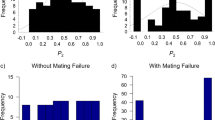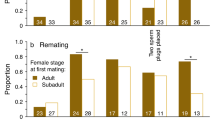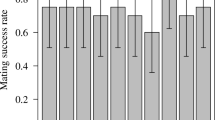Abstract
Highly variable within and across species, patterns of sperm use not only are often driven by post-copulatory sexual selection but can also be impacted by experimental design. In investigations of paternity bias using competitive double matings, the inter-mating interval is a temporal factor that can affect sperm use patterns if the first male’s sperm is used or lost at an appreciable rate between matings or if its viability or relative competitiveness is influenced by the time since ejaculation. Rapid loss of first-male sperm within the female after mating has been established in the seed beetle (Callosobruchus maculatus), a model system in sperm competition studies. However, our understanding of sperm precedence in this species, which disproportionately favors the last (second) male to mate, is based on long inter-mating intervals. Here, I determine the effect of a shortened inter-mating interval on second-male paternity (P 2) and, importantly, the extent to which females in this species are willing to remate immediately. I find that P 2 is significantly reduced when females remate immediately than when they remate 24 or 48 h after the first mating and that immediate remating is common, indicating that there is a substantial potential for female remating decisions to influence the intensity of sperm competition within species. To understand the variation in inter-mating intervals from a female perspective, I further identify key differences between females that did and did not remate at three inter-mating intervals (0, 24, and 48 h after the initial mating) and discuss potential mechanisms for the observed variation in female refractoriness.
Significance statement
Females often mate with multiple males, and in insects it is common for the last male to mate to obtain the greatest share of paternity. One possible explanation for this bias towards last-male sperm use is the passive loss of sperm from the first male with time since mating. Here, I examine the effect of different intervals between matings in a seed beetle species to determine if first-male paternity is increased when females remate sooner. My results show that first males do achieve higher paternity when females remate sooner, which is more common than expected in this species. I also show the differences between females that do and do not remate, which can help explain potential causes for variation in female remating behavior. Together, these results show the significant impact that female remating decisions can have on male competition and, ultimately, their reproductive success.


Similar content being viewed by others
Change history
09 December 2017
The electronic supplementary file from the original article contained track changes and line numbers. Everything else in the wording and/or copy is completely fine. A clean electronic supplementary file was uploaded.
References
Ala-Honkola O, Hosken DJ, Manier MK, Lüpold S, Droge-Young EM, Berben KS, Collins WF, Belote JM, Pitnick S (2013) Inbreeding reveals mode of past selection on male reproductive characters in Drosophila melanogaster. Ecol Evol 3:2089–2102. doi:10.1002/ece3.625
Ala-Honkola O, Manier MK (2016) Multiple mechanisms of cryptic female choice act on intraspecific male variation in Drosophila simulans. Behav Ecol Sociobiol 70:519–532. doi:10.1007/s00265-016-2069-3
Arnaud L, Gage MJ, Haubruge E (2001) The dynamics of second-and third-male fertilization precedence in Tribolium castaneum. Entomol Experim et Appl 99:55–64. doi:10.1046/j.1570-7458.2001.00801.x
Arnqvist G, Danielsson I (1999) Copulatory behavior, genital morphology, and male fertilization success in water striders. Evolution 53:147–156
Bates D, Mächler M, Bolker B, Walker S (2014) Fitting linear mixed-effects models using lme4. arXiv preprint arXiv:14065823. doi:10.18637/jss.v067.i01
Birkhead TR, Møller AP (1992) Sperm competition in birds: evolutionary causes and consequences. Academic Press, London
Birkhead TR, Biggins JD (1998) Sperm competition mechanisms in birds: models and data. Behav Ecol 9:253–260. doi:10.1093/beheco/9.3.253
Blyth JE, Gilburn AS (2005) The effect of an inversion system and the time interval between matings on postcopulatory sexual selection in the seaweed fly, Coelopa frigida. Heredity 95:174–178. doi:10.1038/sj.hdy.6800713
Boorman E, Parker GA (1976) Sperm (ejaculate) competition in Drosophila melanogaster, and the reproductive value of females to males in relation to female age and mating status. Ecol Entomol 1:145–155. doi:10.1111/j.1365-2311.1976.tb01217.x
Cook PA, Harvey IF, Parker GA (1997) Predicting variation in sperm precedence. Philos Trans R Soc Lond Ser B Biol Sci 352:771–780. doi:10.1098/rstb.1997.0061
Crawley MJ (2013) The R book, Second edn. Wiley, England
Crudgington HS, Siva-Jothy MT (2000) Genital damage, kicking and early death. Nature 407:855–856. doi:10.1038/35038154
Danielsson I (1998) Mechanisms of sperm competition in insects. In Annales Zoologici Fennici 35:241–257
den Hollander M, Gwynne DT (2009) Female fitness consequences of male harassment and copulation in seed beetles, Callosobruchus maculatus. Anim Behav 78:1061–1070. doi:10.1016/j.anbehav.2009.06.036
Dickinson J (1986) Prolonged mating in the milkweed leaf beetle Labidomera clivicollis clivicollis (Coleoptera: Chrysomelidae): a test of the “sperm-loading” hypothesis. Behav Ecol Sociobiol 18:331–338. doi:10.1007/BF00299664
Dickinson J (1988) Determinants of paternity in the milkweed leaf beetle. Behav Ecol Sociobiol 23:9–19. doi:10.1007/BF00303052
Dougherty LR, Simmons LW (2017) X-ray micro-CT scanning reveals temporal separation of male harm and female kicking during traumatic mating in seed beetles. Proc R Soc Lond B 284:20170550. doi:10.1098/rspb.2017.0550
Drnevich JM (2003) Number of mating males and mating interval affect last-male sperm precedence in Tenebrio molitor L. Anim Behav 66:349–357. doi:10.1006/anbe.2003.2219
Eady PE (1991) Sperm competition in Callosobruchus maculatus (Coleoptera: Bruchidae): a comparison of two methods used to estimate paternity. Ecol Entomol 16:45–53. doi:10.1111/j.1365-2311.1991.tb00191.x
Eady PE (1994a) Intraspecific variation in sperm precedence in the bruchid beetle Callosobruchus maculatus. Ecol Entomol 19:11–16. doi:10.1111/j.1365-2311.1994.tb00384.x
Eady PE (1994b) Sperm transfer and storage in relation to sperm competition in Callosobruchus maculatus. Behav Ecol Sociobiol 35:123–129. doi:10.1007/BF00171502
Eady PE (1995) Why do male Callosobruchus maculatus males inseminate so many sperm? Behav Ecol Sociobiol 36:25–32. doi:10.1007/BF00175725
Eady PE, Rugman-Jones P, Brown DV (2004) Prior oviposition, female receptivity and last-male sperm precedence in the cosmopolitan pest Callosobruchus maculatus (Coleoptera: Bruchidae). Anim Behav 67:559–565. doi:10.1016/j.anbehav.2003.07.003
Eberhard WG (1996) Female control: sexual selection by cryptic female choice. Princeton University Press, Princeton
Edvardsson M (2007) Female Callosobruchus maculatus mate when they are thirsty: resource-rich ejaculates as mating effort in a beetle. Anim Behav 74:183–188. doi:10.1016/j.anbehav.2006.07.018
Edvardsson M, Arnqvist G (2000) Copulatory courtship and cryptic female choice in red flour beetles Tribolium castaneum. Proc R Soc B 267:559–563. doi:10.1098/rspb.2000.1037
Edvardsson M, Rodríguez-Muñoz R, Tregenza T (2008) No evidence that female bruchid beetles, Callosobruchus maculatus, use remating to reduce costs of inbreeding. Anim Behav 75:1519–1524. doi:10.1016/j.anbehav.2007.10.005
Harano T, Miyatake T (2005) Heritable variation in polyandry in Callosobruchus chinensis. Anim Behav 70:299–304. doi:10.1016/j.anbehav.2004.10.023
Harano T, Yasui Y, Miyatake T (2006) Direct effects of polyandry on female fitness in Callosobruchus chinensis. Anim Behav 71:539–548. doi:10.1016/j.anbehav.2005.05.017
Harrison XA (2014) Using observation-level random effects to model overdispersion in count data in ecology and evolution. PeerJ 2:e616. doi:10.7717/peerj.616
Hosken DJ, Taylor ML, Hoyle K, Higgins S, Wedell N (2008) Attractive males have greater success in sperm competition. Curr Biol 18:R553–R554. doi:10.1016/j.cub.2008.04.028
Hotzy C, Arnqvist G (2009) Sperm competition favors harmful males in seed beetles. Curr Biol 19:404–407. doi:10.1016/j.cub.2009.01.045
Hotzy C, Polak M, Rönn JL, Arnqvist G (2012) Phenotypic engineering unveils the function of genital morphology. Curr Biol 22:2258–2261. doi:10.1016/j.cub.2012.10.009
Johnstone RA, Keller L (2000) How males can gain by harming their mates: sexual conflict, seminal toxins, and the cost of mating. Am Nat 156:368–377
LaMunyon CW, Eisner T (1994) Spermatophore size as determinant of paternity in an arctiid moth (Utetheisa ornatrix). PNAS 91:7081–7084
Lenth RV (2016) Least-squares means: the R package lsmeans. J Stat Softw 69:1–33. doi:10.18637/jss.v069.i01
Lessells CM, Birkhead TR (1990) Mechanisms of sperm competition in birds: mathematical models. Behav Ecol Sociobiol 27:325–337. doi:10.1007/BF00164003
Lewis SM, Austad SN (1990) Sources of intraspecific variation in sperm precedence in red flour beetles. Am Nat 135:351–359
Lüpold S, Manier MK, Berben KS, Smith KJ, Daley BD, Buckley SH, Belote JM, Pitnick S (2012) How multivariate ejaculate traits determine competitive fertilization success in Drosophila melanogaster. Curr Biol 22:1667–1672. doi:10.1016/j.cub.2012.06.059
Lüpold S, Pitnick S, Berben KS, Blengini CS, Belote JM, Manier MK (2013) Female mediation of competitive fertilization success in Drosophila melanogaster. PNAS 110:10693–10698. doi:10.1073/pnas.1300954110
Maklakov AA, Kremer N, Arnqvist G (2005) Ageing and the evolution of female resistance to remating in seed beetles. Biol Lett 2:62–64. doi:10.1098/rspb.2005.3240
Manier MK, Lüpold S, Pitnick S, Starmer WT (2013) An analytical framework for estimating fertilization bias and the fertilization set from multiple sperm-storage organs. Am Nat 182:552–561. doi:10.1086/671782
McNamara KB, Elgar MA, Jones TM (2008) Seminal compounds, female receptivity and fitness in the almond moth, Cadra cautella. Anim Behav 76:771–777. doi:10.1016/j.anbehav.2008.04.018
Orr TJ, Brennan PL (2015) Sperm storage: distinguishing selective processes and evaluating criteria. Trends Ecol Evol 30:261–272. doi:10.1016/j.tree.2015.03.006
Parker GA (1970a) Sperm competition and its evolutionary consequences in the insects. Biol Rev 45:525–567. doi:10.1111/j.1469-185X.1970.tb01176.x
Parker GA (1970b) Sperm competition and its evolutionary effect on copula duration in the fly Scatophaga stercoraria. J Insect Physiol 16:1301–1328. doi:10.1016/0022-1910(70)90131-9
Pitnick S (1991) Male size influences mate fecundity and remating interval in Drosophila melanogaster. Anim Behav 41:735–745. doi:10.1016/S0003-3472(05)80340-9
Pitnick S, Miller GT, Reagan J, Holland B (2001a) Males’ evolutionary responses to experimental removal of sexual selection. Proc R Soc Lond B 268:1071–1080. doi:10.1098/rspb.2001.1621
Pitnick S, Brown WD, Miller GT (2001b) Evolution of female remating behaviour following experimental removal of sexual selection. Proc Biol Sci 268:557–563
Radwan J (1997) Sperm precedence in the bulb mite, Rhizoglyphus robini: context-dependent variation. Ethol Ecol Evol 9:373–383. doi:10.1080/08927014.1997.9522879
Development Core Team R (2014) R: a language and environment for statistical computing. R Foundation for Statistical Computing, Vienna
Simmons LW, Parker GA (1992) Individual variation in sperm competition success of yellow dung flies, Scatophaga stercoraria. Evolution 46:366–375
Simmons LW (2001) Sperm competition and its evolutionary consequences in the insects. Princeton University Press, Princeton
Savalli UM, Fox CW (1999) The effect of male mating history on paternal investment, fecundity and female remating in the seed beetle Callosobruchus maculatus. Funct Ecol 13:169–177. doi:10.1046/j.1365-2435.1999.00287.x
Sirot LK, Wolfner MF, Wigby S (2011) Protein-specific manipulation of ejaculate composition in response to female mating status in Drosophila melanogaster. PNAS 108:9922–9926. doi:10.1073/pnas.1100905108
Siva-Jothy MT, Tsubaki Y (1989) Variation in copulation duration in Mnais pruinosa pruinosa Selys (Odonata: Calopterygidae): 1. Alternative mate-securing tactics and sperm precedence. Behav Ecol Sociobiol 24:39–45. doi:10.1007/BF00300052
Thornhill R, Alcock J (1983) The evolution of insect mating systems. Harvard University Press, Cambridge
Walker WF (1980) Sperm utilization strategies in nonsocial insects. Am Nat 115:780–799
Wedell N, Cook PA (1998) Determinants of paternity in a butterfly. Proc R Soc B 265:625–630. doi:10.1098/rspb.1998.0340
Wilson N, Tubman SC, Eady PE, Robertson GW (1997) Female genotype affects male success in sperm competition. Proc R Soc Lond B 264:1491–1495. doi:10.1098/rspb.1997.0206
Yamagishi M, Itô Y, Tsubaki Y (1992) Sperm competition in the melon fly, Bactrocera cucurbitae (Diptera: Tephritidae): effects of sperm “longevity” on sperm precedence. J Insect Behav 5:599–608. doi:10.1007/BF01048007
Yamane T, Goenaga J, Rönn JL, Arnqvist G (2015) Male seminal fluid substances affect sperm competition success and female reproductive behavior in a seed beetle. PLoS One 10:e0123770. doi:10.1371/journal.pone.0123770
Yamane T, Miyatake T, Kimura Y (2008) Female mating receptivity after injection of male-derived extracts in Callosobruchus maculatus. J Insect Physiol 54:1522–1527. doi:10.1016/j.jinsphys.2008.09.001
Zeh JA, Zeh DW (1994) Last-male sperm precedence breaks down when females mate with three males. Proc R Soc Lond B 257:287–292. doi:10.1098/rspb.1994.0127
Acknowledgements
I thank my committee members—Drs. Janis Dickinson, Hudson Kern Reeve, Linda Rayor, and Mike Webster—and fellow departmental colleagues for critical discussion and comments; Frank Messina for providing the stock population of beetles, extra oviposition substrate, and advice on culture maintenance; Ken Kemphues for help with access to and use of the irradiator; Pat Sullivan and Andy Clark for their input and help with experimental design; Abigail Giancola and Hannah Yoo for beetle culturing assistance; Lynn Johnson for statistical advice; Lars Washburn for use of a microbalance; family and friends for their support; the city of Austin for their tacos and sunshine; and two anonymous referees for their comments that greatly improved the manuscript.
Author information
Authors and Affiliations
Corresponding author
Ethics declarations
Data availability
The datasets generated and/or analyzed during the current study are available in the Dryad Digital Repository, [http://dx.doi.org/10.5061/dryad.7h7h3].
Funding
This research was supported by grants from the Department of Neurobiology and Behavior at Cornell, ATHENA Fund and the Linda and Samuel Kramer Graduate Student Fellowship at the Cornell Lab of Ornithology, the Cornell Sigma Xi Student Research Grant, the American Museum of Natural History, and the National Science Foundation Graduate Research Fellowship (Cornell NSF Grant DGE-1144153).
Conflict of interest
The author declares that she has no conflict of interest.
Ethical approval
All procedures performed in studies involving animals were in accordance with the ethical standards of the institution or practice at which the studies were conducted.
Additional information
Communicated by D. J. Hosken
A correction to this article is available online at https://doi.org/10.1007/s00265-017-2413-2.
Electronic supplementary material
ESM 1
(DOCX 90 kb).
Rights and permissions
About this article
Cite this article
Hook, K.A. Female remating decisions and a shorter inter-mating interval diminish last-male sperm precedence. Behav Ecol Sociobiol 71, 121 (2017). https://doi.org/10.1007/s00265-017-2350-0
Received:
Revised:
Accepted:
Published:
DOI: https://doi.org/10.1007/s00265-017-2350-0




